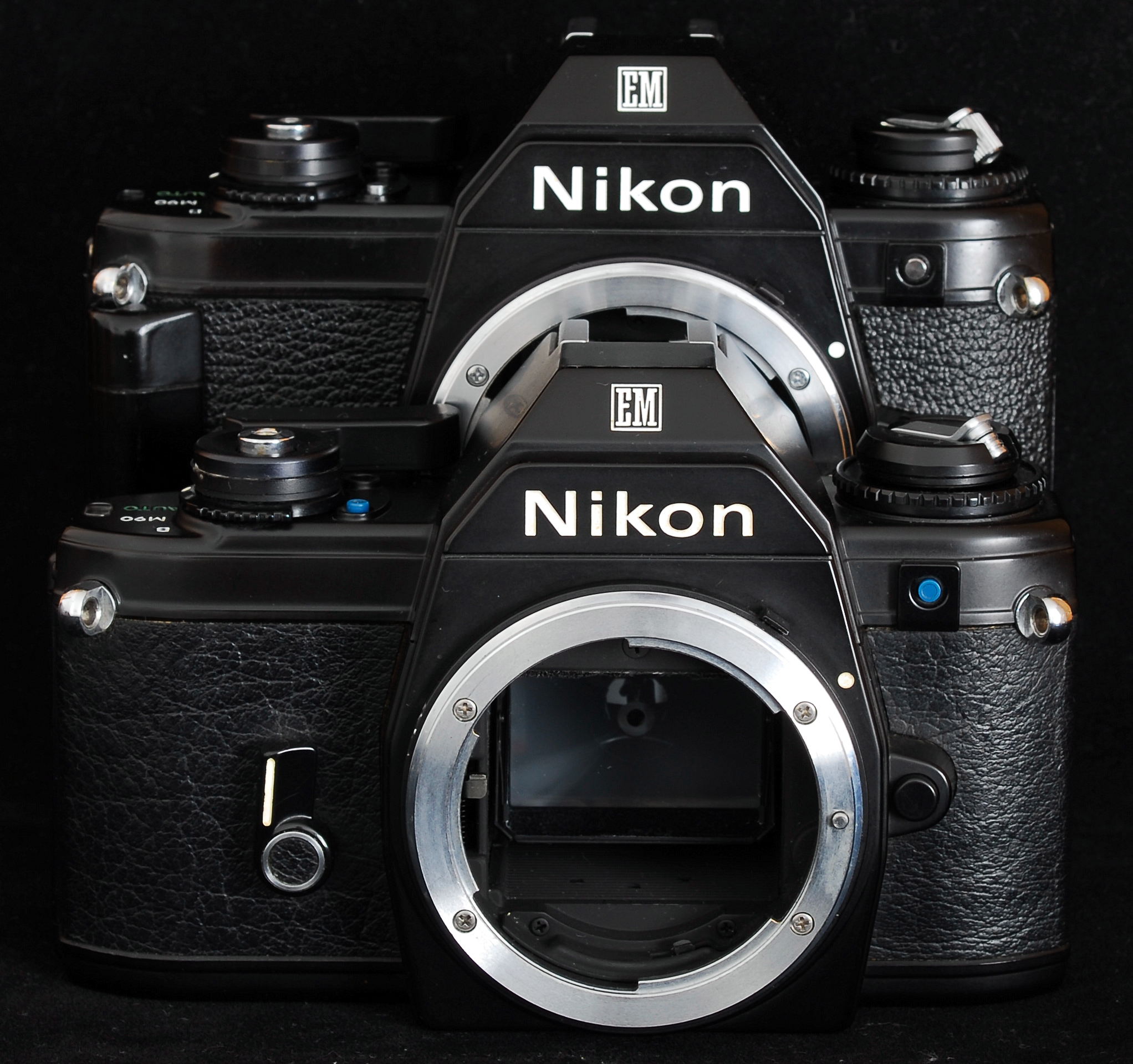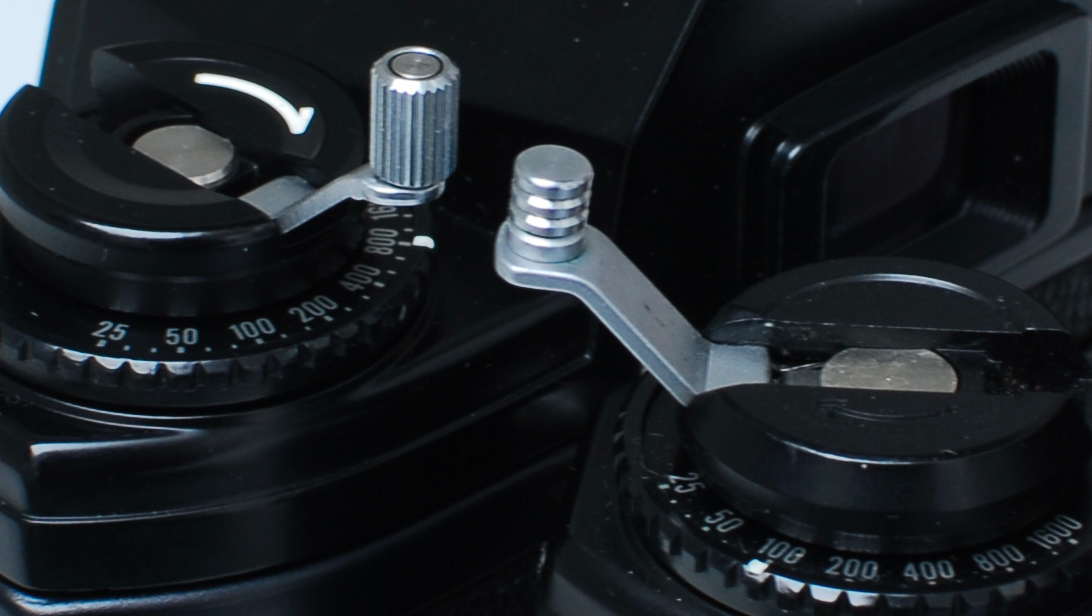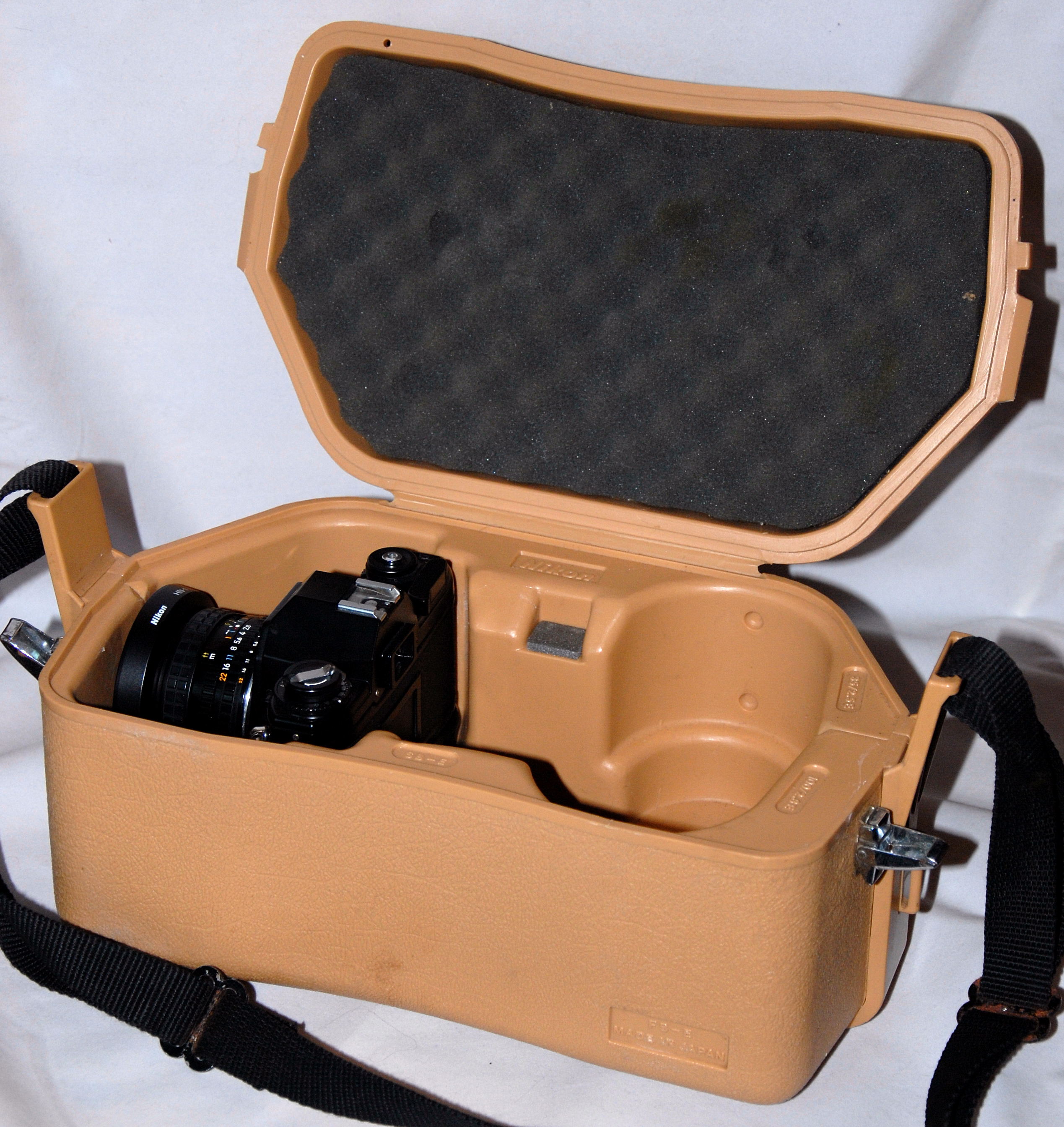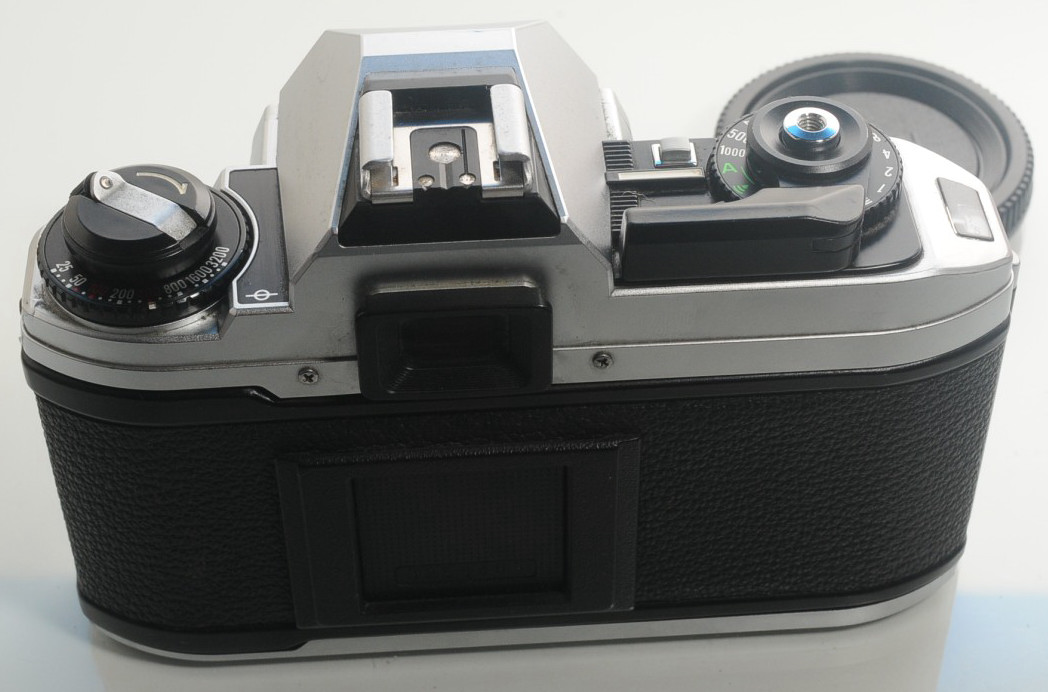Nikon EM & FG/FG-20
IntroductionAfter the successful Nikomat/Nikkormat series, which production stopped mid 1980, Nikon had to come with a smaller automatic camera as fellow camera producers, like Olympus (with its OM-series) and Pentax (with its ME-series), having already an interesting market share. It had to be a ´small automatic camera for the women´ among the amateur photographers. On the basis of the successfully Nikon FM a simple and easy to handle single lens reflex camera was developed. To make a camera even smaller than the relatively small Nikon FM/FE wasn´t easy. The film advance mechanism had to be redesigned and - to make the camera not too heavy - most body panels had to be made from plastic. To ensure to produce durable and strong plastic parts a special research department - EP Technology Department - was set up. Like the Nikon F3 the camera was designed by the famous Italian designer Giorgetto Giugiaro, founder of ItalDesign. This artist designed very nice cars, like the Maserati Ghibli (1966-1973), but also some Volkswagens. In those days it was fancy to ask famous (car) designers to assist in designing a camera. The Contax single lens reflex cameras were designed by Porsche! In fact the well-known Japanese photographer (and inventor) Kazuhiko Mitsumoto introduced the managers of Nikon Corporation to Giugiaro. The idea to give the Nikon EM several colors was dropped. It should have a black leatherette body cover. In March 1979 Nikon introduced the Nikon EM at the PMA-Fair in Chicago (USA), which touched on a sore spot of many Japanese journalists, as at the Nippon Camera Show - one month earlier - nobody had seen the new Nikon camera. BTW: Canon and Olympus opted for their introduction of the Canon AV-1 and Olympus OM10 also for the PMA, rather than a show back home! The Japanese had to wait until March 1980! In that month the new Nikon F3 was introduced as well. Many critics and reviewers think that Nikon introduced the EM together with the Nikon F3 as it was afraid of loosing its face. A loss of face is a shocking disgrace in East-Asian communication culture. Nikon EM
´Blue button´ Nikon EM + Winder MD-E As you can see from the picture the Nikon EM is indeed a small camera. The camera is foolproof. One big button is set to ´auto´, focus on something and press the shutter release button. In fact it is a aperture priority exposure program. If the exposure meter ´thinks´ that exposure isn´t possible, because of low light, or if the shutter time becomes slower than 1/30th second, the camera starts to peep. Unfortunately that peep can´t be put off (unless you take off the top cover and cut the wire to the tiny speaker!). In the viewfinder a needle shows the selected shutter time at a pre-set aperture. That aperture is not shown in the viewfinder BTW! The camera has one mechanical shutter speed at 1/90 sec. The exposure meter measures the light in the middle of the viewfinder; focusing is easy with the fresnel-lens (named after the French inventor/physicist Augustin Jean Fresnel = 1788-1827) and a focus indicator. If there is a lot of back light the little button on the left front should be pressed. Serial numbers of this cute camera start at 6100000. The first versions of the Nikon EM have blue buttons, later versions (from #65xxxxx) have chrome buttons. The ´blue´ EM version has the disadvantage that the rewind crank may hit the prism viewfinder, while the ´chrome´ EM version has a redesigned crank, which doesn´t touch the top cover! So go for the last version, if you are interested in this nice camera. The automatic shutter (Seiko MFC-E focal plane shutter) runs from 1 - 1/1000 sec. and has a flash sync of 1/90 sec. There isn't much to see on the top of the Nikon EM. At the right side of the advance lever 'B' stands for 'Bulb' (as long as you press the shutter release button the shutter will be open and the mirror will be upright), M90 is the only mechanical shutter time (in case the battery has no power left) and 'Auto' = aperture priority exposure program. When you press the blue/chrome button the red lamp will tell you whether the battery is OK. On the left on the top you'll see the rewind crank on top of the ASA/ISO scale.
Above both versions of the Nikon EM: blue-button + chrome-button and different texture.
Left chrome-button rewind crank; right blue button rewind crank. Also the lens release buttons differ: Blue-button is black, chrome-button is chrome. Nikon Corporation designed and produced a special series of lenses, aka ´Series-E´ lenses. Optically these lenses are not bad, but most body parts are made from plastic, which - as we can state now - isn´t as durable as the before mentioned research department has wished. The Nikon EM could be ordered with a winder, the Nikon MD-E (2 fps.) and a flash, the SB-E (guide number = 17). The MD-14 can be mounted under the Nikon EM as well, giving this set a ´speed´ of 3.2 fps. The Nikon EM was rather a success worldwide as more than 1.6 million cameras were sold until production stopped in 1984. (Serial numbers went as high as 778xxxx). If you want to buy one on the secondhand market it will be easy and cheap. Carefully look at the foam in the mirror house on the back. Not all AI/AIS Nikkor-lenses can be used on this camera however. Look in the lens manuals for details.
A very unique Nikon accessory for the Nikon EM is a 'beauty case' made of plastic and holding at least one camera body, mounted winder and standard lens, some more lenses and the Nikon SB-E flash gun.
Nikon FG/FG-20 Although the Nikon FG body - introduced in 1982 - differs much of that of the Nikon EM, the camera can be seen as a variant or upgrade of it. It has almost the same features plus a possibility for full automatic program and manual shutter settings. It has - as the first Nikon SLR ever - TTL (through the lens) flash measuring and a program shift in its exposure program. The program shutter has stepless shutter speeds from 1 to 1/1000 sec. In the viewfinder two LED´s are indicating the shutter speed and under-/overexposure. If the latter occurs an ´audio warning system´ (as Nikon calls it) will come into function. This annoying beep can be turned off - luckily. This camera can be fitted with the MD-E and/or MD-14 and could be ordered in chrome as well. Nikon also offered a data back (MF-15) enabling to imprint year/month/day (up to 2100 A.D.) or a picture counter (up to 2000). When the MD-14 is mounted the little grip on the right front side of the camera body has te be removed (see above picture).
One year later - in 1983 - the slimmed version of the Nikon FG, the Nikon FG-20, was introduced. This version has no TTL-flash feature and no program shift. For the very first photographers above the selftimer button on the front of the body 'self timer' is written. The only Nikon SLR with that text! The motor drives mentioned before can be used however. Both cameras were produced in chrome and black. Serial numbers of the Nikon FG started at #820xxxx and went as high as #905xxxx (chrome and black bodies intermixed). Serial numbers of the Nikon FG-20 started at 320xxxx; last serial number is unknown to the author. All cameras mentioned here were indeed made for the amateur photographer. If used carefully they were able to make very nice pictures. The shutter programs are hard to mislead, although stray light into the viewfinder can ruin an image. The Series-E lenses are very nice lenses, made of real optical glass, although the lens bodies have plastic parts. In many comparison tests these lenses often reached a top position. It wasn´t and it isn´t a shame to use these cameras and lenses. For Nikon collectors the EM/FG versions are easy (and cheap) to get.
|



